#jeweled partlet
Explore tagged Tumblr posts
Text
So in my head Cersei's gowns are inspired by the 1570s (a low-cut bodice with the neckline filled in by a jeweled partlet that extends into a ruffled collar). Her gowns are always heavily bejeweled, with the ruffled collar subtly echoing the mane of a lion.



Margaery's gowns on the other hand are inspired by the late 17th century, particularly the Spanish court dress of 1679-80 (off the shoulder neckline, long flowing hair - Marie Louise of Orleans, Queen of Spain basically). With her loose hair and exposed décolletage, Margaery's style is more romantic and "youthful".



The stark contrast in styles would likely lead to a stylistic division within the court, with ladies emulating the fashion preference of whichever queen they support. It's also possible that over time Cersei and Margaery might engage in a subtle exchange of styles, with Cersei aiming to project a more youthful image and Margaery aspiring to cultivate a regal queen-like appearance!
#asoiaf#game of thrones#cersei lannister#margaery tyrell#just two queens trying to outdo one another through fashion!
91 notes
·
View notes
Note

Do you think the new portrait is Mary I?
I think it's certainly possible it is Mary I. I have in past voiced strongly that it bears a much stronger resemblance to Mary I than to Catherine Parr. Mary wins over in features. Against Parr.
However, if we look at images that I think could be Catherine Howard-then I am undecided if it is Mary indeed.
But unless we have multiple confirmed images of Catherine Howard, it is impossible to tell definitely which one it is.
(The miniature in RCT with a 'consort pendant' is Anne of Cleves. I think I proved that enough on this blog. Hence we have zero of confirmed Howard this far.)
Until we do have such an option I am happy to call it Mary I instead of Catherine Parr. I am glad they changed it, I am hoping in future they will rename alleged Mary Howard's miniature(which has Parr's features through and through).
Unfortunately, I am skeptical of the dating of this miniature and thus the attribution to Susanna Horenbout.
Certainly, the records of the cross that matches are a good sign. Unfortunately, it's not as big evidence as they think it is.
Portraying delicate pieces of jewelry on miniatures was very difficult and not always does it do justice. (For example- the IHS brooch on Catherine of Aragon's miniature is nearly unrecognizable. It is the same Jane Seymour wears in her portrait by Holbein.)
In this case, however the jewel is clearly visible and should be fairly recognizable. So, why do they mention Mary wearing a clearly different cross in the NPG miniature by Lucas Horenbout?
It is not making their case stronger at all.
Religious jewelry was popular. Crosses with pearls and diamonds were common. So, how can you be sure it is the exact one you think it is?
-Realistically I don't think you can. It's not unique enough to be a good indicator.(There are only so many variations of cross-shaped jewelry you can make! Normal cross typically fits 5 to 6 gemstones across centuries, and up to 3 hunting pearls-a common part of jewelry in the Tudor era.)
So crosses matching the same description could be multiple within the royal family(and in the royal collection to which mary had access to), maybe even in Mary's own possession prior to 1546.
Hence yes it is a point for Mary, but it is not a strong point.
Certainly not the thing you can base dating solely on.
While the French hood's shape, nor partlet are not that far off from 1546, the way to date French hood in the 1540s is by looking at the hair.
And it is pretty simple.
Early you start with straight hair, closely fallowing head, not sticking out at all(Anne of Cleves-alleged miniature of Howard)
Then in c.1540-1543, we start to see hint of buns(slightly starting to poke out), but also simultaneously first slightly curly/wavy examples, still closely fallowing head, and it is pretty rare for them to stick out.
Parr in c.1543 juggles both hairstyles, but it sems curly/wavy was temporarily her preferred style, but it sticks out way more.
In 1544 Mary's portrait-curly hair.
But Parr in c.1545 has two straight buns down-returning to it-but again, it is more pulled out. Elizabeth in c.1546 has hair straight in two buns down. Margaret Douglas(possibly) in c.1546 has two straight buns down.
And c.1547/8 examples of Mary and Elizabeth show both buns up(the style then extends to 1550s-is typical for them, but starts in late 1540s)
So there is a clear pattern. Which art historians are yet to discover.
And they don't have it easy. Because, the official dating of 1540s, and 1550s portraits is nightmare. Most recent(before this) portrait to be misdated was the Jersey portrait of Parr. It was officially dated as 1547-1548.
Solely because she wears black-she must be a widow! (sarcasm.) Yeah, maybe in Victorian times. This is the Tudor Queen. She can wear black normally. No case for that date whatsoever!
-No, Parr's portrait is c.1544, it matches Mary's 1544 portrait so much! Except for the stays.
With so many examples of inaccurate dating between 1540-1560, it is no wonder historians then make wrong assumptions, based upon them.
Ooops-got bit sidetracked.
Mary's miniature imo is from early 1540s, c.1540-1542.
Hair is closely fallowing head, not sticking out at all nor any hint of buns, only slightly wavy. So almost same as in 1530s.
It's not consistent with any of the hairstyles seen in Parr's reign, but rather with Holbein's late work. He died in 1543.
It is basically the french hood and hairstyle from image on right

-just in different angle and with different billements, and bit more spread partlet(not by much though-it is wider at Parr's reign).
Maybe like this you will be able to better see the french hood's similiarity.

(the piece behind ear often gets later altered(overpainted).)
So with dating of 1540-1542. I am sorry, but Lucas Horenbout is still in the picture. He died in 1544. But that doesn't mean it should be just broadly atributed to 'workshop of Horenbout family'. His father seems to be not working by this point. His wife possibly was artist, but unlikely to have that similiar style to Lucas.
Since this is strongly Horenbout style...it should be one of the siblings.
But I think there is nothing wrong in attributing it to both siblings in case of ambiguity.
Hence I would label it as:
Miniature portrait of Queen Mary I as Princess, in c.1540-1542, by Lucas or Susanna Horenbout

Until proven otherwise.
15 notes
·
View notes
Text

Women's Fashion in the Renaissance: Grace, Opulence, and Detail 👗✨
Renaissance women's fashion was designed to display both beauty and social standing. Here's a look at the key pieces that defined the time:
Gown: The main attire for women, often floor-length, made from luxurious fabrics like silk or velvet. It was adorned with intricate embroidery and jeweled accents. 👗
Kirtle: A fitted dress worn under the gown, often serving as a base layer. It could be simple or richly decorated depending on the woman’s status. 👚
Partlet: A small garment worn over the shoulders or chest, often made of lace or fine fabric. It provided a touch of modesty and elegance. 💫
Cloak: A large, flowing garment that draped over the body, worn for warmth and style. Often lined with fur for a luxurious look. 🧣
Headdress: Headwear was an important fashion statement—women wore elaborate headdresses, often decorated with jewels, feathers, or lace. 👑
Corset: A tight-fitting undergarment designed to shape and support the body, often enhancing the bust and waist. 🌸
Slippers: Women wore flat shoes or slippers made of velvet or leather, often adorned with intricate patterns. 👡
1 note
·
View note
Photo




This red Tudor gown was designed for Glenda Jackson’s portrayal of Elizabeth in the wonderful 1971 miniseries 𝑬𝒍𝒊𝒛𝒂𝒃𝒆𝒕𝒉 𝑹. 🤩 The gown was loosely based on a painting by William Scrots of Elizabeth as a young princess. 🎨 The dress went on to be used in the 2000 documentary 𝑬𝒍𝒊𝒛𝒂𝒃𝒆𝒕𝒉: 𝑻𝒉𝒆 𝑨𝒄𝒄𝒍𝒂𝒊𝒎𝒆𝒅 𝑺𝒂𝒈𝒂 𝒐𝒇 𝑬𝒏𝒈𝒍𝒂𝒏𝒅’𝒔 𝑽𝒊𝒓𝒈𝒊𝒏 𝑸𝒖𝒆𝒆𝒏, 👸 where Imogen Slaughter wore it. Interestingly, the dress appears to have been made over to resemble a more accurate representation of Elizabeth’s gown in the Scrots portrait. The partlet was removed, pearls and jewels were added to the neckline, and new sleeves (from the coronation gown from 𝑬𝒍𝒊𝒛𝒂𝒃𝒆𝒕𝒉 𝑹) were added, among other changes. 👗 The dress would be seen the following year in another documentary 📺 – 𝑻𝒉𝒆 𝑺𝒊𝒙 𝑾𝒊𝒗𝒆𝒔 𝒐𝒇 𝑯𝒆𝒏𝒓𝒚 𝑽𝑰𝑰𝑰, where an uncredited actress wore it as Princess Elizabeth. It was worn several more times over the years, but we cannot document them all on our social channels. Please visit our website to see more sightings of this dress, as well as to find out what it sold for at auction! 🔗 Bit.ly/TudEliz004
#TudorGown#GlendaJackson#ElizabethR#TheSixWivesofHenryVIII#HenryVIII#CostumeDrama#PeriodDrama#RecycledMovieCostumes#Costumes#CostumeDesign#CostumeIdeas#CostumeHistory#MovieDresses
0 notes
Photo
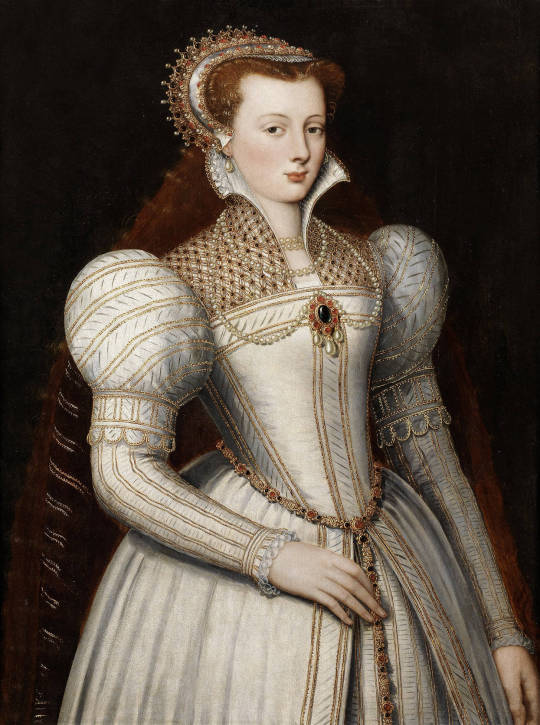

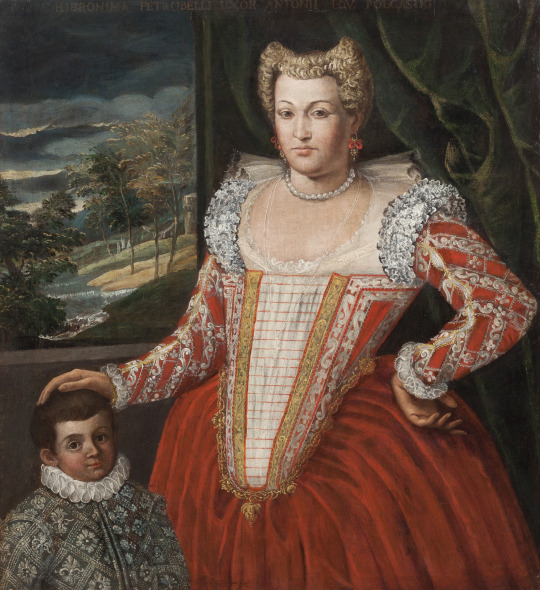


Lady, half-length, in white bejewelled dress and headress. Circle of Frans Pourbus the Younger (location ?). From tumblr.com/blog/view/antiquelaceartist 1245X1672 @72 747kj. She may be wearing a cape.
1570-1599 Lavinia Biglia, Countess Pallavicino, attributed to Juan Pantoja de la Cruz (Antony House - Antony, Cornwall, UK). From pinterest.com/lindsaysmithfox/baroque-fashion/; fit to screen 959X1400 @72 393kj.
Ritratto di dama con figlio by Francesco Montemezzano (auctioned). From mutualart.com/Artwork/Ritratto-di-dama-con-figlio/07514105FD201DD6 2562X2800 @144 2.7Mj. Originally found on tumblr.com/blog/view/history-of-fashion/688220081239490560. I believe this is late 1500s based on the two-spike hairdo and the width of her upper skirt that resembles a French farthingale.
Lady by Marcus Gheeraerts the Younger (location ?). From tumblr.com/blog/view/jeannepompadour/684657296048078848 966X1300 @72 260kj.
Woman by Roman artist (Sotheby's - 20May21 auction Lot 3) 1592X2000 @300 913kj. I can not date this one.
#1500s fashion#Renaissance fashion#Frans Pourbus the Younger#curly hair French hood#partlet#open partlet#jeweled partlet#neckline ruff#French sleeves#girdle#V waistline#pendant#Juan Pantoja de la Cruz#tiara#hair feathers#saya#handkerchief#Francesco Montemezzano#horned coiffure#laced bodice#camica#chemise#Marcus Gheeraerts the Younger#frizzy hair#bouffant coiffure#brooch#back-flared lace cuffs#bodice#strap sleeves#long close sleeves
65 notes
·
View notes
Note
So now that the whole season is out what did you overall think of the Becoming Elizabeth costumes?
I loved it.
That scene of Elizabeth getting dressed in ep 7 (I think) amazing, stunning.
Mary and Elizabeth in gold and blue in the last episode?? the ermine trims??
Veils on hoods?? partlets?? the difference in dressing at home vs court???
the costumes that were recreations of portraits?? enough to make me cry
The blackwork,, the girdles, the jewels...
I love it and can't wait to see what's in the designer's future
42 notes
·
View notes
Text
Mourning Veils: the Biquoquet and Their Descendants

Unknown lady in mourning, 1650s, Spanish School
Black veils aren’t just a Victorian concept - observe the pointed hood at the hairline? Every wondered where the phrase ‘widow’s peak’ comes from?
According to Wikipedia, the name of this distinctive mourning headwear come from:
‘the beak or bill of a headdress, particularly the distinctive hood with a pointed piece in front – a biquoquet – which widows wore as a hood of mourning dating from 1530 .Another explanation for the origin of the phrase suggests that it may be related to the mourning caps worn as early as the 16th century.”
This is a very demure example. The modestly tied white collar is to the throat, with just a hint of ruffling, her widow’s cap is bound tightly and very low across her forehead so no hair shows - and an there’s opague black hood beneath the veiling, too.

John Michael Wright , Lady Bagot with her Granddaughter Mary, 1656
Here, Lady Bagot has certainly made her mourning more fashionable! She might be a grandmother, but she’s daringly tempered her mourning with a sheer black silk partlet, and her hairline shows beneath the cap. Not only that, she wears a jewelled miniature of her husband at her bodice, tied with black ribbon. She’s perhaps been in mourning longer, and can enliven her appearance a little.
They may have Tudor origins, but two centuries later, and the peaked widow’s caps are still making an appearance in 1700s portraits.

The Dowager Electress Palatine in Mourning, 1717.
She’s given it a touch of fashion with the black ruffled fontange cap of the early 1700s, but that pointed widow’s peak is still there - and it stays there through most of the 1700s.

Anna Sophia of Brandenburg in Royal Mourning, 1742
(Anna Sophia looks far too cheerful and happy to be really mourning for anybody - and she’s really enjoying her black velvet and ermine court gown, from what I can see. You go, Anna Sophia!)

Maria Theresa in Mourning, 1772, Anton Von Maron
Even to 1770s - look at Maria Theresa, (Marie-Antoinette’s mother) here! The cap has changed to accommodate fashion, and the widow’s peak has shrunk to a tiny point of black silk - but it’s still there. I particularly enjoy her black mourning collet necklace too, as well as the subtle black ruffled luxury in her gown.
#fashion history#18th century style#18th century fashion#18th century mourning#fic research#Theresa Maria de Barros#la viuda marina#what would theresa wear?
35 notes
·
View notes
Text
Partlet

A 16th century fashion accessory. The partlet was a sleeveless garment worn over the neck and shoulders, either worn over a dress or worn to fill in a low neckline. The earliest partlets appeared in late 15th century fashion. They were made of silk or linen, and were worn to fill in the low necklines of both men’s and women’s Burgundian dress. Early 16th century partlets were made in a variety of fabrics and colors, although black was most popular. Black partlets worn over the gown, usually in velvet or satin for the upper classes, are an earlier style. Fine partlets made of linen lawn, with standing collars and ruffles, could be worn directly over a low-necked smock, or over the kirtle. Elaborate lattice-work partlets were decorated with gold and jewels or pearls. This was called “Caulle fashion” in England.
0 notes
Text
WIP
Last weekend’s project was a personal favorite of mine. I’ve blogged before about Burgundian Gowns when I wrote about the DOTW French Court Barbie. They’re my favorite 15th Century style. It was nice to go back to history for a weekend, while we waited for some other fabrics to arrive. Though, TBH, this design has been in my mind for a long time as part of our LOTR Costume Project. It’s something I see the Princesses of Emyn Arnen wearing at some point in the Fourth Age. But this is my headcanon speaking and not actual Legendarium chronology by any means.
1 - Research
That’s easy. I’ve been researching and hoarding images of Burgundian Gowns since forever.
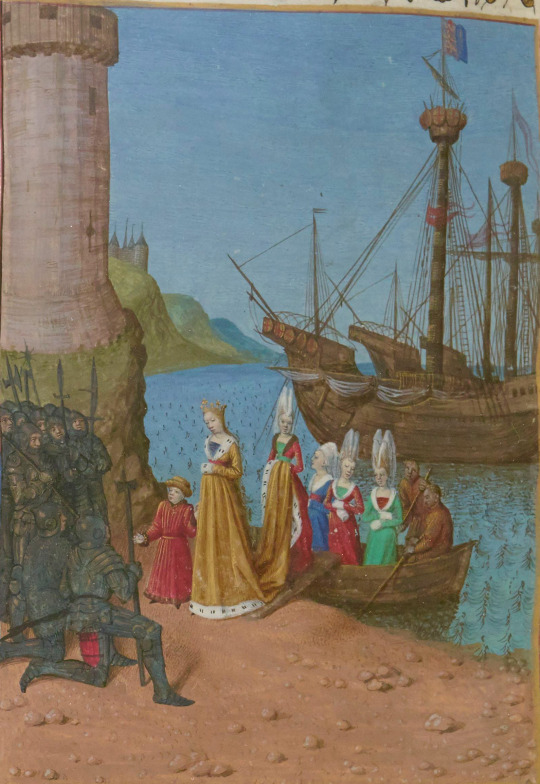
Above: Retour d'Isabelle de France en Angleterre. Grandes Chroniques de France, enluminées par Jean Fouquet, Tours, vers 1455-1460 Source: Paris, BnF, département des Manuscrits, Français 6465, fol. 338v. (Livre de Charles IV le Bel).
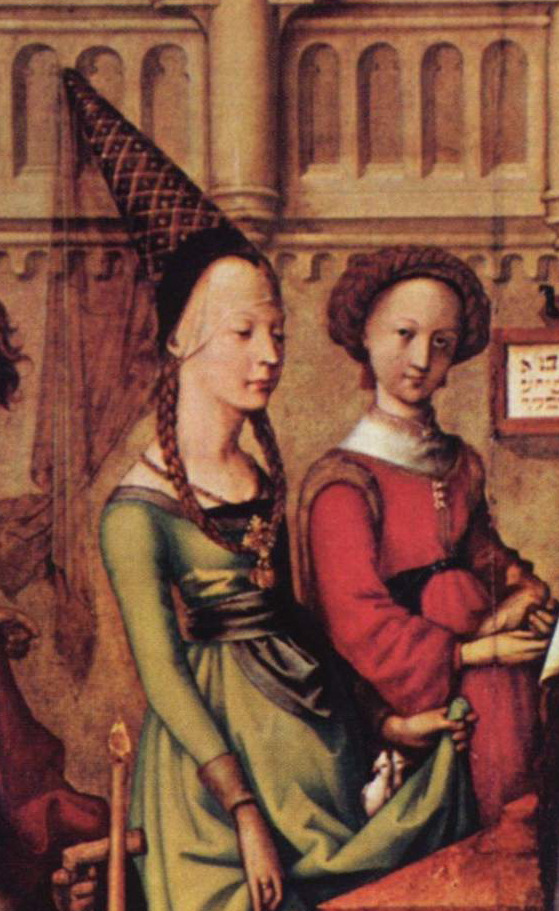
Above: Detail of The presentation of Christ in the Temple by Hans Holbein The Elder. Kunsthalle Hamburg. Source: Wikipedia
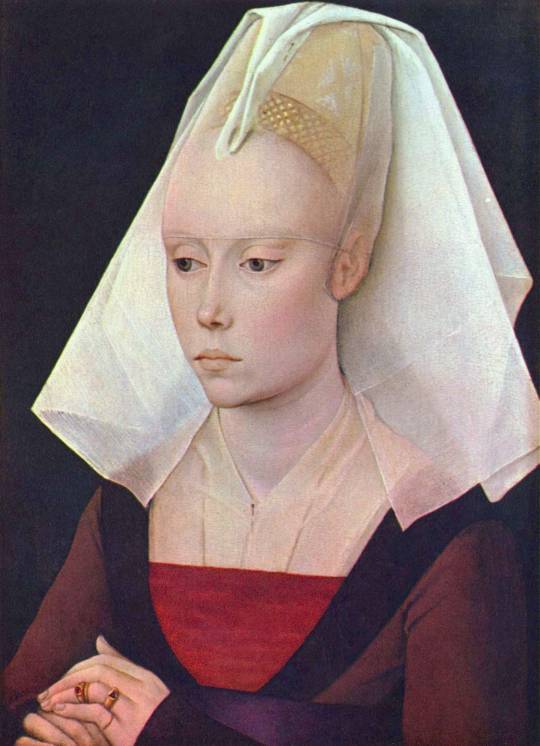
Above: Workshop of Rogier van der Weyden, Portrait of a young woman of the Burgundian gentry. National Gallery, London. Source: Wikipedia.
These are just some images out of my research. They teach us two things about Burgundian Gowns: The partlet usually comes in contrasting colors, and Burgundian Gown are always accompanied by a very specific headgear: the hennin. So, to complete my doll’s look, I made one too.
2 - Sewing Process and Results:
For my Burgundian outfit, I’ve chosen the conical hennin, more common around the 1430′s. I also love the truncated hennin, but I want a truncated hennin in darker colors, and since I’m going for light colors here, and for a “fairytale princess” look...
As far as color references are concerned, Burgundian Gowns’ paintings often show them in darker tones, jewel tones, or black. But I went out of what’s shown in sources and made a Burgundian out of the same taffeta I used for the last Sideless Gown mock up we’ve shown some weeks ago. The plastron was done in the same green silk as the Sideless Gown’s bust. But as you’ll notice in some pictures, I’ve forgotten to stiffen the silk properly by adding a buckram layer to the lining. Ugh. Things that lack of time do to my brains...
The hennin also didn’t get as good as I wanted. It ended up not covering the doll’s hair properly. It needed to be larger to accomodate the hair inside and still go down to where it should be on the doll’s head. A modern doll’s hairline is different than what was fashionable in the 15th Century - a more receded style, that you can see in the research pictures above. Think Faye Dunaway in “The Messenger” (1999).
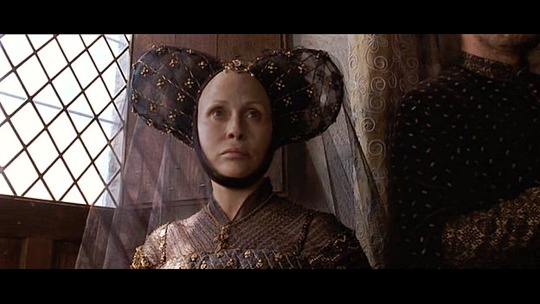
In order to achieve that look I needed to have sewn a larger hennin, that would fit the doll’s hair inside and still come further down on her head, and I also needed to add lappets to it. But I forgot. The original pattern in “Patterns For Theatrical Costumes” lacks them. But I knew that “Patterns for Theatrical Cosumes” is not a source of historically accurate patterns and I knew I needed to design the lappets to build them into the hennin pattern provided by the book. And still I forgot to do it. I’m very sorry about that guys. I’ll do better next time around.
And here comes the tricky part: Most Burgundians I’ve ever seen have fur details at the neckline, wrists and/or hem. That is actually because these dreses were lined in fur. Sometimes in all these places, sometimes in two out of three. But fur (faux or real, though I’ll never use real fur for anything in my life) gets too brute and too big for the proper scale on a 12 inch doll if you’re not sewing something big like a cloak with a large shawl collar, or a hippie fur-vest. But there’s a trick that works pretty well in these moments: velvet. It’s “furry” enough and small enough to look in scale. And I had just the right caramel shade to go well with eggshell and green!
Here are the results! As always, this is a modern doll, so please forgive the smoky eye and blue eye shadow. It’s not period and it feels misplaced. I’m working on gettin more “period adequate” dolls for our photoshoots.
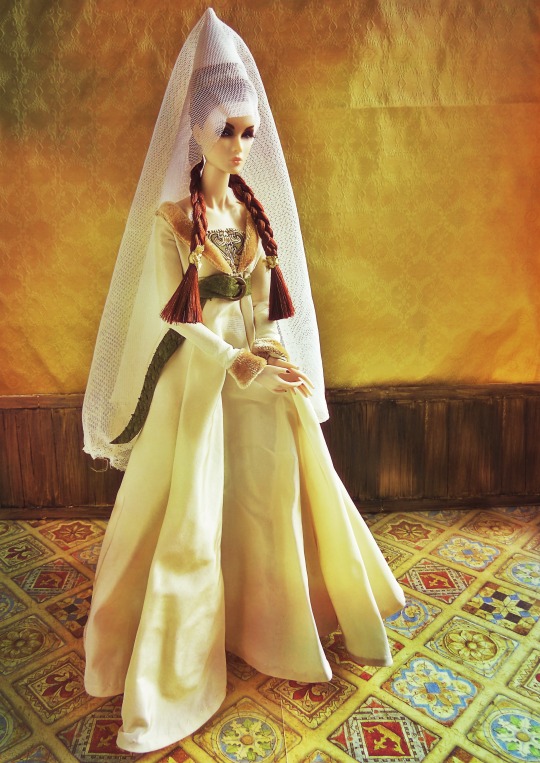
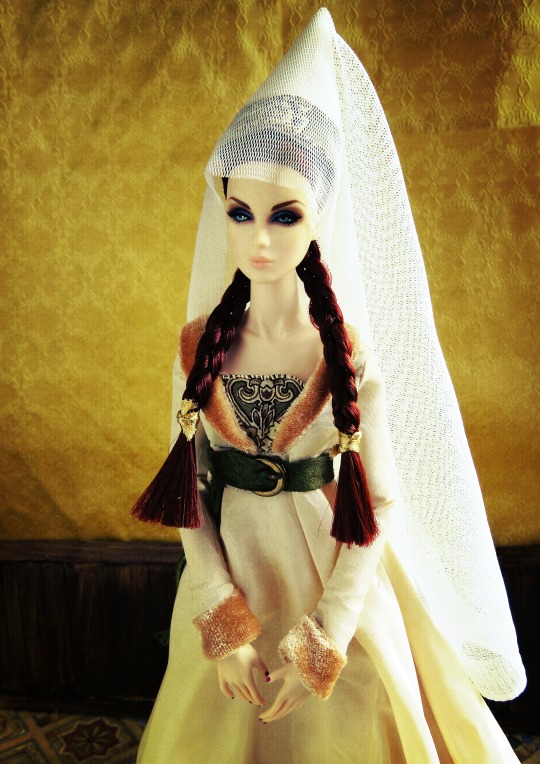
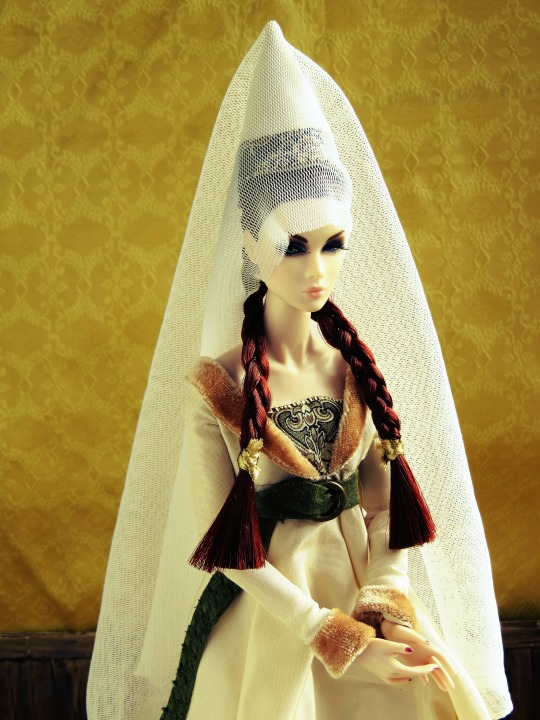
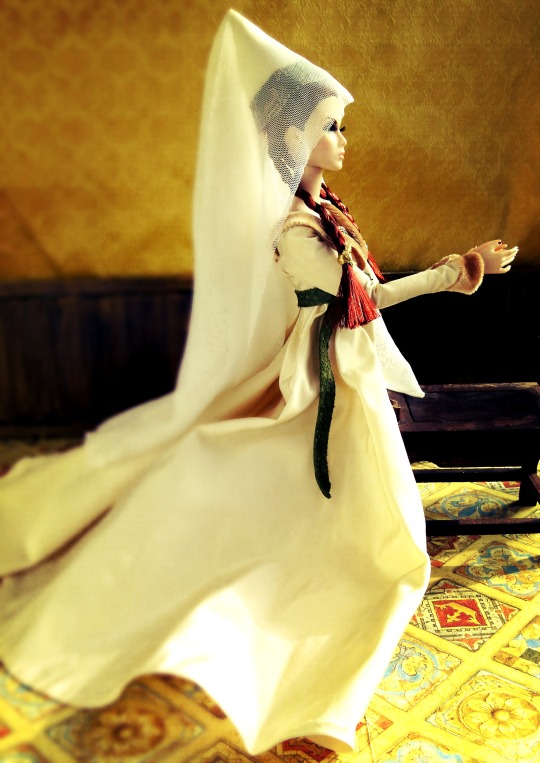
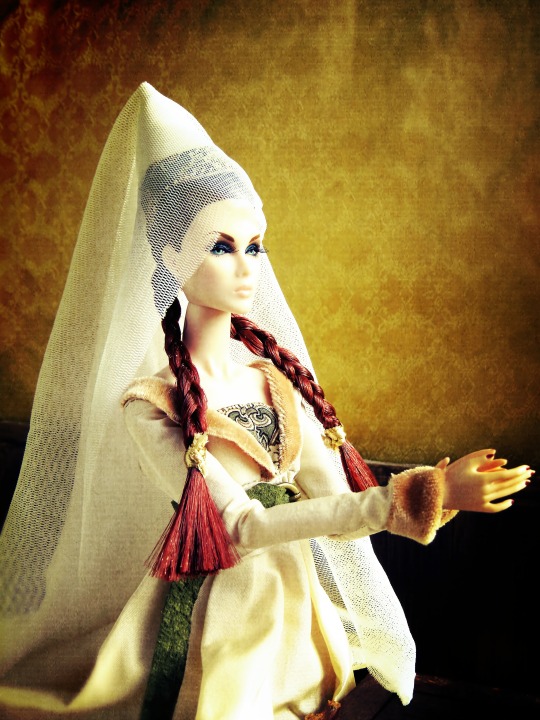
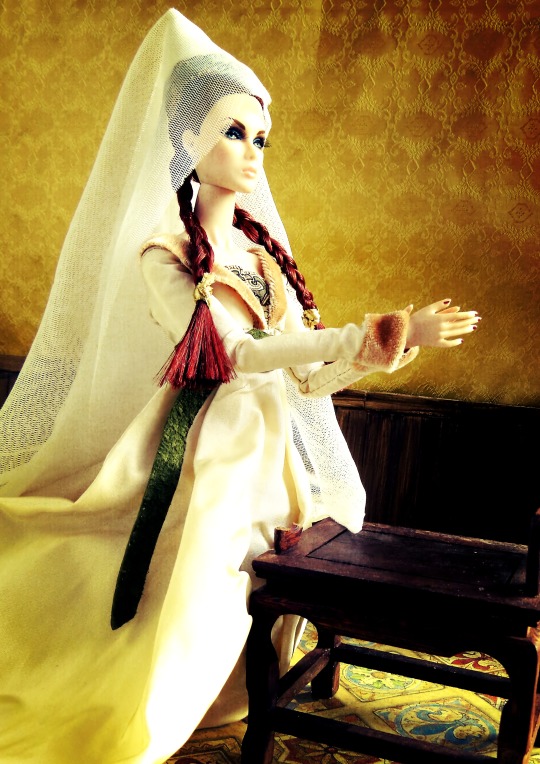
#wip#work in progress#burgundian gown#duchy of burgundy#henin#medieval fashion#medievalfashion#medieval history#medieval hats#medieval headgear#pointed henin#doll clothes#doll sewing#doll dress#period dolls#miniature sewing#lotr#lotr costume project#original#original design#my design#my photos#my photography#my art#mine#diorama#burgundy#savage#af#savageaf
18 notes
·
View notes
Text
Where To Find The most ideal Flip Flop Deals Online.
, if you go to China one of the spots you have to see is Hangzhou as well as that is actually West Lake. There truly was no wow variable when I used the Tidy Face Mild Toner along with the Dove Cream and also I recognize that's certainly not as a result of the cream given that Dove Cream is a tried and tested cream to me. For the cost from Well-maintained Face Laser toner, that is actually really a downer. As well as a servant was actually generally worked with to help place her clothes on. Pieces included her fine linen white smock, stockings, bum roll, over dress (normally split up the front end), corset, French or spanish farthingale (band dress), waistcoat (underskirt), ruff, partlet and also fine extras such as feathers, belts, jewelries, rings (commonly worn on every hands except the middle) and also chokers.

As that was actually still smoggy and also dark, and as the outlet was blinded besides by the wall from Lincoln's Inn, intercepting the light within a couple of backyards, our company should not have viewed a great deal but also for a lighted lantern that an old guy in spectacles and also a hairy limit was lugging about in the outlet. The Body Shop has an identical case from an odor which is certainly not really musky: Japanese Musk is actually truly a chypre like fine-grained chypres olden (find Ma Griffe); starched, great, delightful and splendid on a neckerchief kepted inside a handbag. Cleansing the inside wall surfaces will certainly lead to fragments of clutter to landed on the vegetations, designs, and rocks, so this's greatest to cleanse them first. Dip a tidy sponge in to the combination, wring out the excess water, and scrub the workplace dividings gently. Mohan did specifically and also swiped gold hand band of older sibling and informed jeweler outlet to cut some part of gold coming from this to ensure this will not show up to his senior sibling. When you initially begin utilizing plans like Photoshop, Gimp, or even Coating Shop Pro, you'll possibly find a great deal of possibilities for anti-aliasing. Investing in a white colored topaz ring will definitely save the customer a considerable amount from funds in contrast to gemstones. Off soap opera celebrities to flick superstars, models and pop vocalists, even Diva's and footballer spouses speak well of the amazing and also charismatic white colored females's watch. Have your vehicle to a cars and truck service center making certain that the appropriate oil is actually used in your automobile. Jeremy Seigal, president of White Things's said in a statement to Metro: In action to the latest scenario, I would like to point out just how sorry our company are actually for the poor adventure that our client invited our Southampton outlet. You may also look around online because some business supply the package online, yet ensure to acquire item coming from genuine business that give you promise regarding the product. Having a customer endure this kind of response at your outlet will make for a remarkable adventure, however certainly not the kind that would certainly create a loyal customer. Although you could certainly not be able to afford the first-rate or even outlet in the all the trendiest establishments it performs certainly not indicate you will certainly not have the capacity to develop your excellent space. Additionally, landlords usually see and also create checking ups, thus, maintain your property clean and also surprise them pleasantly. Frequently, cleansing franchises bill about seventy-five bucks each hr to have rowenatomlinson.soup.io pair of individuals clean for 2 hrs. You may want to have it to a check out repair store and also receive it operating once more if you see is actually broken. When the place is really sturdy fat, tar, periodontal, vital oil, lotion, and even footwear sparkle tidy in the extra having a cook's blade or maybe a putty scrapper.
0 notes
Photo



Symbolism in Elizabeth’s Portraits
April 11, 2016 by Rebecca Larson Symbolism in Elizabeth’s portraits has been there all along, but some of us have chosen not to see it until now. It wasn’t until I recently watched a documentary that talked about the symbolism in Elizabeth’s “Rainbow” portrait that I started looking for them. In this article I will cover three portraits with obvious symbols. If you happen to find more portraits with symbols please feel free to share with me!
Elizabeth “Rainbow” Portrait
Elizabeth had lots of symbolism in her portraits that is easy to overlook.
For example, this “Rainbow” portrait is loaded with symbolism and I’m not sure how I never noticed it before.
“Mon Sine Sole Iris” means No Rainbow Without the Sun. Only the queen’s wisdom can ensure peace and prosperity.
Notice the eyes and the ears? This is something I’ve overlooked and I’m not sure how I could have missed it! Clearly this is symbolizing that she is always watching and listening, or that she has eyes and ears everywhere.
The snake/serpent symbolizes fertility while the heart at the top right hanging from the snake symbolizes love.
In Elizabeth’s hand it looks like she is holding a clear tube – this is indeed a rainbow, however the colors have faded from the portrait. She hold the rainbow in her hand. The rainbow in this portraits symbolizes peace. She’s holding it – does that mean without her there is no peace?
We can also note that there are lots of pearls in this portrait…The pearls symbolize virginity. Isn’t it amazing how one portrait can hold so many symbols!?
The “Phoenix” Portrait
Here’s another portrait, the “Phoenix” portrait. Again, not sure how I missed the symbolism.
Note the phoenix. In the full image it’s easy to overlook. A phoenix is (in classical mythology) a unique bird that lived for five to six centuries in the Arabian desert. After this time it consumed by fire and born again, rising from the ashes with renewed youth to live through another cycle. Only one phoenix can live at a time so it symbolizes it uniqueness and longevity.
Elizabeth is holding a red rose. A red rose has religious connotations – it was the medieval symbol of the Virgin Mary. It also symbolized that Elizabeth was the Virgin Queen.
Pearls. Again we see the pearls. They symbolize her virginity and purity.
The “Ermine” portrait.
Here are more symbols “hidden” within her portraits. From now on, every time you see a portrait of Elizabeth you’ll look a little closer.
This portrait shows her royalty, purity, wealth, prosperity and power.
1. The ermine. Ermine represents royalty and nobility along with purity.
2. The pearls. This time the pearls look black to me. Black pearls represent wealth and prosperity.
3. The Sword of State. Elizabeth would use this in her portraits, sometimes small, sometimes large to symbolize power.
http://www.tudorsdynasty.com/symbolism-elizabeths-portraits/
Markiza The Rainbow Portrait: The theme is that of Elizabeth as the Queen of Love and Beauty. The theme is that flower decked spring. The spring flowers are an allusion to the springtime and Elizabeth as Flora and Empress of Flowers. Elizabeth’s gown is embroidered with English wildflowers, thus allowing the queen to pose in the guise of Astraea, the virginal heroine of classical literature. Her cloak is decorated with eyes and ears, implying that she sees and hears all. Above her crown is a crescent-shaped jewel which alludes to Cynthia, the goddess of the moon. A jeweled serpent is entwined along her left arm, and holds from its mouth a heart-shaped ruby. Above its head is a celestial sphere. The serpent symbolizes wisdom; it has captured the ruby, which in turn symbolizes the queen’s heart. In other words, the queen’s passions are controlled by her wisdom. The celestial sphere echoes this theme; it symbolizes wisdom and the queen’s royal command over nature 🙂 Reply * Markiza The Phoenix Portrait: This gown is described as a “strait-bodied” gown, or a “French Gown”, with “french sleeves”. A French Gown–another example of Elizabeth’s love for foreign fashion–was apparantly a front-closing gown with a narrow, tight-fitting bodice, a low, square neckline and a wide skirt tightly cartridge-pleated to the waistline. the term “strait-bodied”, which meant tight-fitting, was another word for the same thing. The embroidery pattern on the gown reveals that the bodice is cut on the bias–that is, with the weave of the fabric at a 45 degree angle, rather than going vertically and horizontally. Fabric cut on the bias stretches more than fabric cut on the straight, which may have helped this French bodice fit more tightly and smoothly to the torso. Either the Queen is wearing a boned corset (known then as a “pair of bodies”) underneath her gown, or the bodice itself is stiffened with reeds or perhaps even whalebone. Both items–a separate pair of bodies worn under a bodice, and boned bodices themselves–are documented in Elizabeth’s wardrobe at this time. This French Gown is worn in conjunction with “French Sleeves”. This foreign style, which became quite popular in England, was a sleeve with a large, padded sleeve-head which tapered smoothly down to a small wrist. The shape of the dress as a whole–narrow sleeves with broad tops, tight-fitted, front-opening bodices with very full overskirts and low, cuved necklines–echoes that of many woodcuts of French Noblewomen created during the same decade. What truly sets this gown apart from any other is its incredible decoration; the ruff is edged with fine lace, the partlet is intricately embroidered with blackwork, and the gown itself is completely covered in gold embroidery and pearls. Cleverly placed puffs accentuate the breadth of the shoulders and the slender waist. The heavy, elaborate jewelry makes it even more breathtaking. Clearly, this was a portrait meant to impress. By this point in time, the typical Elizabethan gown had become very “busy”–covered with embroidery, trim, beads or pearls or other fabric treatments, such as pinking or slashing. A far cry indeed from the simplicity of Tudor garb, when the fabric itself was, for the most part, a gown’s main decoration. The queen’s head is completely uncovered, and her hair is dressed in her signature curls. Frizzing and curling the hair became quite fashionable during her reign, as people sought to emulate Elizabeth as much as possible. She wears only a small headdress and transparent veil. One interesting quirk: This Gown is of blue velvet. Blue was, by the elizabethan period, considered a color worn mostly by servants, due to the cheap cost of indigo dye. Who knows? Perhaps the queen was trying to make one more symbolic point 😉
0 notes
Text
Catherine Parr's depiction-Part 2: miniatures

-Those you knew and those you didn’t think was her. Until now.
According to Philip Mould, Catherine’s own records show that up 7 miniatures were done by John Bettes the Elder alone! None have been atributed to him this far.
Plus she employed 3 female miniaturists! ...There is bound to be many miniatures of her! Problem is, which?
There are many miniatures which people tend to label as Catherine Parr. However in just one case it is both identified as her and we are certain it is her because of the jewelry and features-the miniature bellow.
First miniature: formerly in the collection of Horace Walpole and now located at Sudeley Castle:
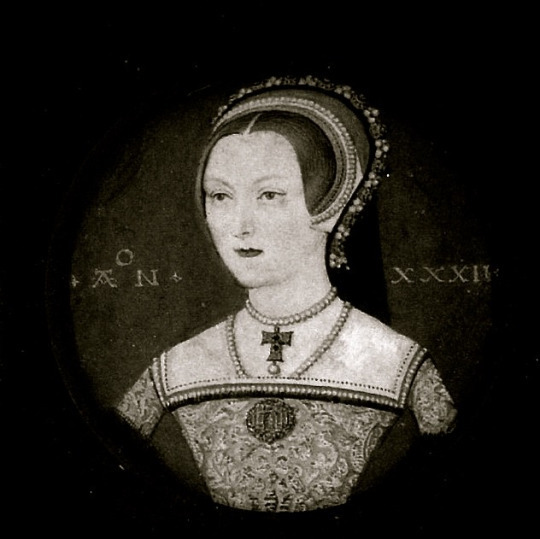
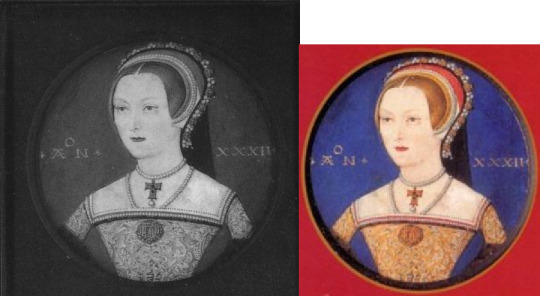
(No idea why I can't find it in HD online.)
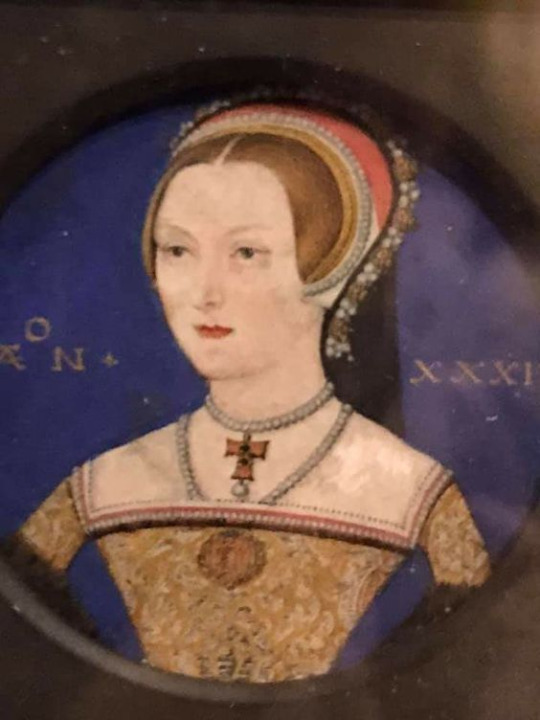
Some say it is by Lucas Horenbout, idk tbh(with miniaturist it is much harder to tell, because you can do fewer tests), but importantly this time the backrgound is in such good state I’d say it is intact. So likelihood of age being correct is pretty good. XXXII=32 years of age. So c.1544, because her birthyear is not certain-it’s c.1512.
The styling of hair would also suggest it is c.1543/1544, unlikely to be of later date.
2nd miniature which once existed, but probably no more:
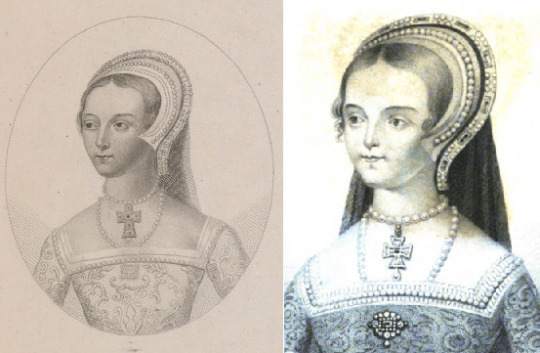
This is nearly exact match to previous miniature. Many people assume it is based upon it-but the upper bilement is different. Plus different cross, it’s not t-shape cross, more likely the ruby cross:
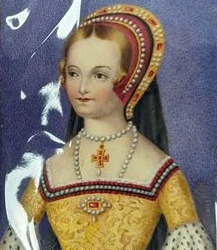
Possibly two different ruby crosses, hence possibly two separate miniatures. But I am not certain of it, so I am at the moment putting them as same one.
Imo the 1st and 2nd miniature were a matching pair, done at same time. Just part jewelry switched, as with Jane Seymour’s portraits and Anne of Cleves miniatures(those mislabelled as Howard). I call these 'twin' portraits.
Parr bought many jewelry from France(and elsewhere), including billements, and she had her favourites in which she kept being portrayed in. Thus you cannot do chronology based upon biliments-becuase it won’t fit! She didn’t always wear new ones, she rewore those she already had.
She doesn’t seem to be fond of partlets(which are not that great indication of dating anyway), hence one would have to rely solely upon shape of her headwear and styling of hair, to try to narrow down the dating.
In larger portraits I could say conclusively, but in miniatures, it’s much harder. So in this post they are put in order as i think they chronologically go, but i am definitely not certain of it. Take it with pinch of salt.
3rd possible miniature(which once existed) is assumed to be based upon one of her much larger portraits-those done by Scrots in c.1545-1546 because you can see the resemblence. But it doesn’t seem to be perfect match. Yes, gown and brooch with crown are same, pendant same.
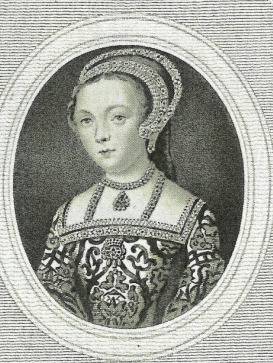
But rest of jewelry is not same. Different billements and jewels lining the gown.
Her billements and bodice jewels look more like bodice jewels in portrait by master John, though i am not sure if they are exact match(maybe just similiar style):
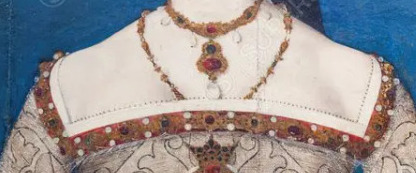
(The jewelry in similiar style is also on lesser known portrait of Henry VIII.)
Similiarities to 3rd made me immediately question identification of another miniature(on right).Because that looks like same person.

4th possible miniature-currently labelled as Mary Howard (with no solid evidence of it):
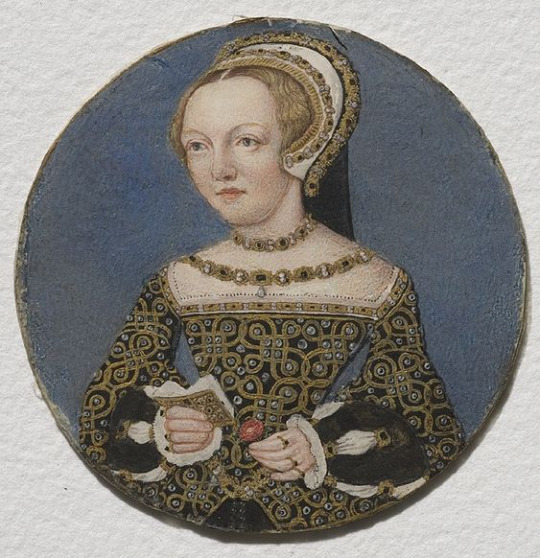
Dressed extremely lavishly. Parr was known for that.
Mary Howard as King’s daughter-in law (widowed by 1540s) probably by law could dress so lavishly...(I mentioned this when talking about lady in purple).But you can bet it’d be talked about and chances would be that it would be directly mentioned in records.
Imo it is mislabelled portrait of Parr. And the newly atributed original portrait of Parr really drives up that theory home! And I even wonder...if both could be by same artist. It's very strong resenblence.

I was 90% sure it was Parr before...now I am ready to write to national museum of Sweden about it. (Inventory No. NMB 935)
They should at least take Parr into consideration. Also, they have slight mistake in information about it.
It’s labelled as after Holbein, by some mistake they put it under artist, instead of dating. Because yes, this is after Holbein, after 1543, but it is not done after his work, this is not a copy of his work. It is period original by another miniaturist.
Miniatures aren’t as easy to date(even roughly). They cannot run as many tests upon them. Because usually they are painted upon cards and are very small and kind of fragile. And that makes it harder to identify the artist.
1st and 2nd have one maker imo, and 3rd and 4th have different one-hence the differences in face and posture.
Different miniaturist=different face.
Usually not drastically different face, but can happen. And that is why you also have to look at rest of the outfit.
But how come this miniature shows blond hair? In part 1 I explained that portraits with red or reddish brown hair are all copies and there were strong suggestions that Parr's hair was actually dark strawberry blond. Jersey's portrait being proven as original, proves that she truly had dark golden hair(literally golden), and in rare instances that can be depicted as light blond instead.
It's not darkening of pigments, but likely fading of it. Fading of red pigment within the mixture.
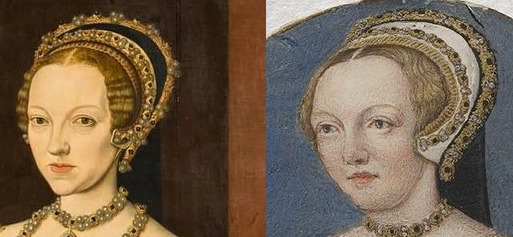
On this miniature gold and hair seems to be in cold spectrum, while they are supposed to be at least slightly in warm spectrum of colours:
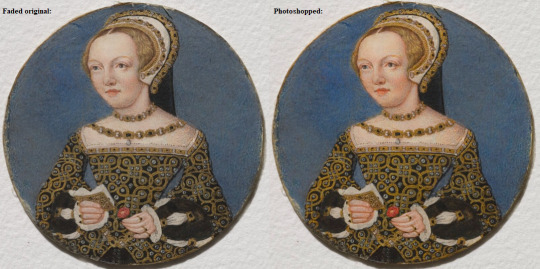
And if you change that, the hair starts to look more strawberry blond.
The miniatures from this artist might explain the notion she was blond. He/she painted her hair as very light(more than it owed to be), his/her work faded in colour and turned blond and people assumed it was her original hair colour.
(Same way when darkening of pigments caused blond hair to go brown, people asume that is the original colour.)
I truly think this miniature,from all the miniatures people call her, has the biggest shot on being actually her.
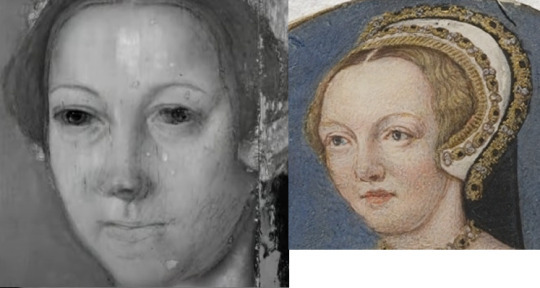
(smile vs no smile here.)
Tbh I am surprised that the identification as Mary Howard, Duchess of Richmond has not been questioned by experts as of yet.(As far as i know) Because the sumptuousness of the outfit, is something not even a Queen Consort would wear on normal basis. (Well maybe Parr with her lavish style would have.)
Not in Henry VIII’s reign. In Elizabethean times there was explosion of goldwork(golden embroidery) or silverwork among nobility.(Imo Elizabeth changed sumptuary law). But prior, it was highly unsual. Except on royals.
Henry VIII and his son were depicted with it in 1540s portraits constantly. But Parr having only 1 portrait with goldwork(with red cloak)? I found it odd, because a big amount of goldwork embroidery we can already see on Mary Rose(d.1533), we see bit less of it on Jane Seymour and I always knew there are some missing depictions of royal women with it. This is one of them:
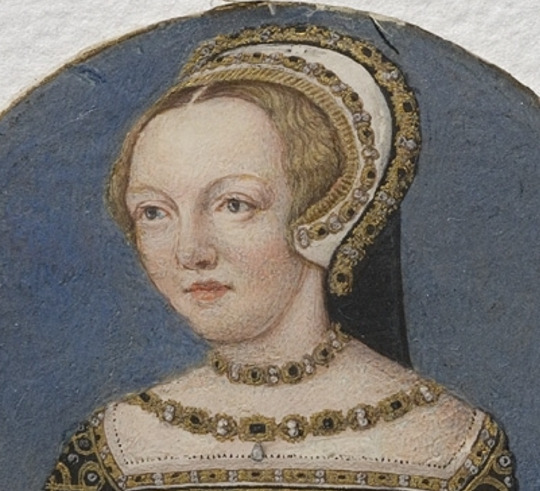
Also you should note that lower necklace is styled in non-english way. This is netherlandish style(present already in 1510s there), possibly Parr was searching for style of her own and experimented.
(It is not found in depiction of english women from Henry VIII's reign otherwise. I think it is literally the only example.)
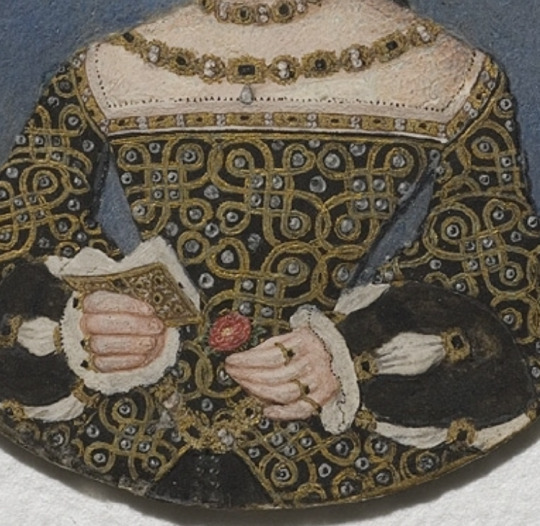
It is a black gown, heavily embroidered with goldwork(in knots patterns-which were popular also in gardens, which Parr also loved!) and hundreds of pearls are sewn upon it. Frankly, the miniature doesn’t do it justice. It’s beyond sumptuous. Catherine Parr was known for being very into sumptuous outfits.
Had Mary Howard been as well, i think there would be mention of it somewhere.As widow of King’s bastard son might have been allowed by law to wear such thing, but i doubt she’d dare.
I also wonder if Mary I could have inherited that dress or had similiar. Because there is period description which states that ‘princess Mary had items of costume embroidered with 581 pearls in total.’ This dress could have such amount.
That she was described as princess, doesn’t necessarly mean that she couldn’t be Queen at the time of the report, because occasionally Kings were described ‘as most ilustrious prince, the King Henry VII etc.’ Idk why, but they did this and it confuses the heck out of modern reader.
Possibly Mary inherited the gown from Parr, or they had two. But it'd be great spectacle.(Which I hope somebody will recreate.)
Alternatively...if it is not Parr...then it should be Mary. She is recorded as having such gown and she resembled Parr to great degree.
And that could explain why the fingers are shorter...but then perhaps the artist wasn't that good with hands. But then the mouth imo resembles Parr more...and Jersey portrait to incredible degree.
Now for the part which fans of Parr might not enjoy.
Don’t hate me for this, please.(Or at least be polite). I know people are convinced these are Parr:
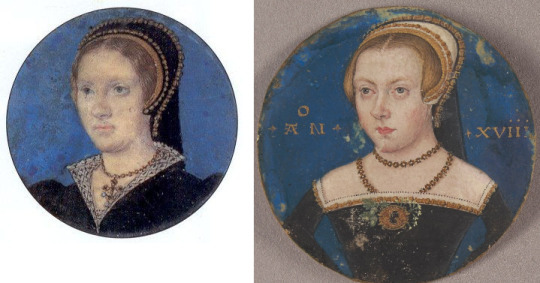
I will have to disappoint you. I don’t believe Parr is in either of them.
Hair colour? Explainable. I went over it in part 1, read it.
Similiarities in posture? Yes.

Similiarities in face? Yes.
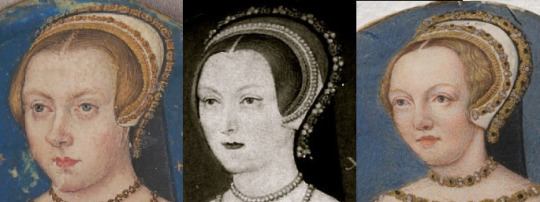

Does the dating fit? it's borderline. I know for certain that these are between 1538-1543, but in my opinion more likely to be 1540-1542, but I could be off by one year.
And who is to say Parr couldn't have miniature done prior to becoming Queen?(possibly after already catching King's eye).
Could she afford the same bilements as rich and powerful women wore in time prior to becoming Queen? Not likely, but she was on friendly terms with Mary I and Henry started to persue her. So perhaps she was gifted some.
So far, all is explainable! But there are two big problems.
Problem A on left, and problem B on right:
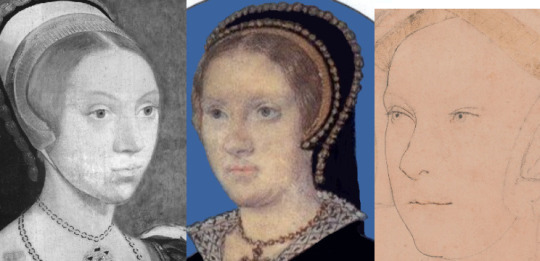
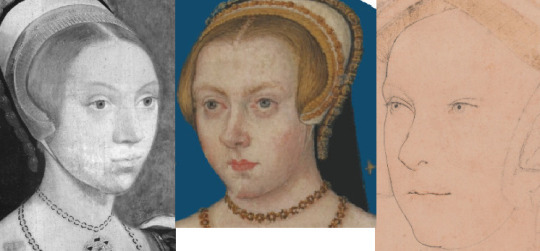
They fit Katherine Howard and Mary I way better!
Tbh Parr loses to those two each time. She doesn’t resemble these two miniatures nearly as much as those two do!
Some of the differences could be explained by artist's skill not being that good(Parr employed 4? miniaturists. Several of them linked to highly over-praised Horenbout, who managed to make everybody ugly.)
...So it's possible that the miniatures are simply not that well executed. But more of proven original depictions of Parr we have, the less likely it seems to me that these two depict Parr:
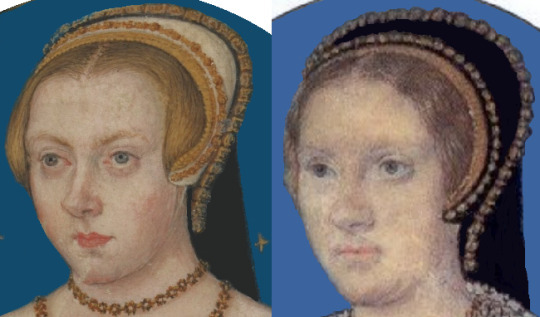
I am not feeling it. Sorry, but I really don't think it is Parr in either of them. (But i am only human, I do mistakes. But at this moment I don't believe it.)
I hope you've enjoyed this and don't you worry, I know of several larger condidates on Parr's portraits.
19 notes
·
View notes
Text
Necklaces of triangles-Part 2: Woman with cross
On left is portrait which Trinity College, Oxford(UK) has for over 400 years labelled Elizabeth Pope, neé Blount. (They have 3 copies of it and they are really hard to tell apart).They truly believe it is wife of one of their founders. There is just one problem with it. On left is portrait which Indiana University Art Museum(USA), has labelled as Mary I. Clearly this is a same woman!
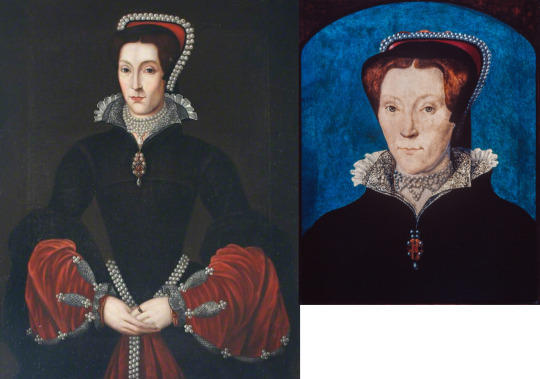
Either one is wrong or both are! So who is right? British university or American?(the sentence to start a fight.) Let’s find out.
Imo both might wrong at least partially. Both universities think their painting is based upon 1550s fashion. But I’ve done some digging and it can be as early as c. 1547-1548(which tbh was bit of surprise to me. But ok, chronology is once again shifted a couple of years.) So both are wrong in assuming it must be later. Then being wrong by only couple of years happens a lot in portraits. Let’s cut them so slack, they were not 20+ years away.
Indiana University Art Museum has it theirs labelled as Mary I, c.1550-1560 by Hans Eworth:
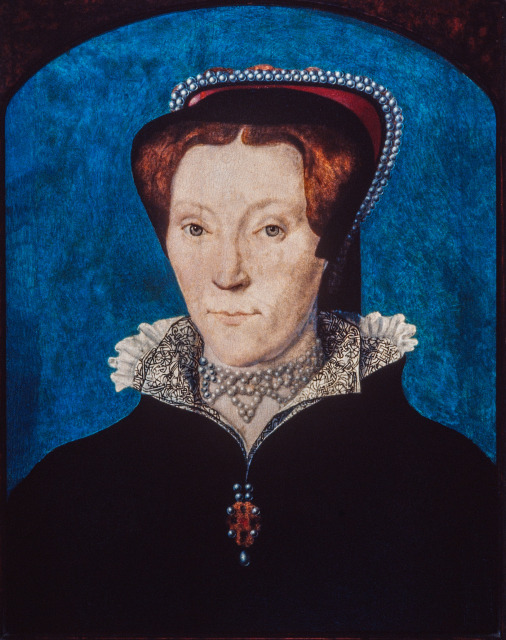
Link:https://artmuseum.indiana.edu/collections-online/browse/object.php?number=2001.39
Given that slight yellowish hue, this looks more like hazel eyes to me than grey.
Which is important because all 3 royal ladies in question had grey or hazel eyes. Not brown, not blue, hazel or grey. (I say three because obviously, this is not Anne of Cleves. It’s not her features.)
I am unsure if this smaller painting is original painting or not. And reason for it is you cannot see where dress and parlet end-which is wrong, not historically accurate.
However there is painting of Mary, where seemingly there is no difference too, untill you brighten it(as i did on left):
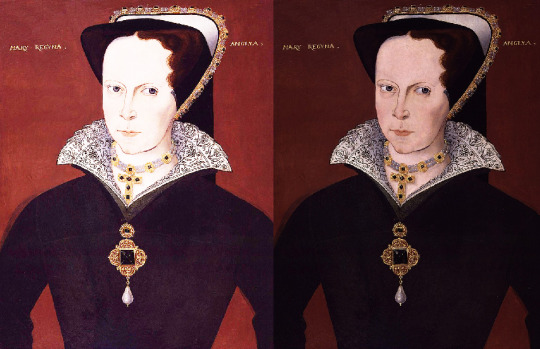
I tried it on Indiana version of our unknown lady. No partlet was revealed. But it is possible it was overpainted. Thus potentially a later alteration made painting appear non-original, even thought potentially it might be. This kind of alteration would be really hard to spot.
But can we even tell if it is a royal? There is that pearl necklace forming triangles and looks bit alike the one Elizabeth probably was wearing as Queen, but it is not conclusive it is same(or originally same altered by time of Elizabeth’s reign).
But I am also wondering if perhaps each royal lady got her own-slightly different from others.
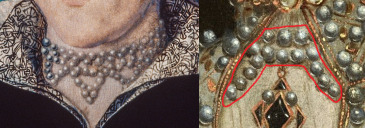
But is not only piece of jewelry in the painting you should focus on. This cross, seems as unimportant accesory. A chest jewel showing that person is of christian fate and nothing more. And perhaps I am wrong and this exact shape of cross is mere concidence.
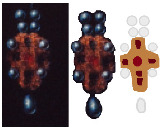
But if I am right, you’ve all seen that cross before. But you’ve probably didn’t study details in Whitehall Mural and questioned the shape of Elizabeth of York’s ruby cross:
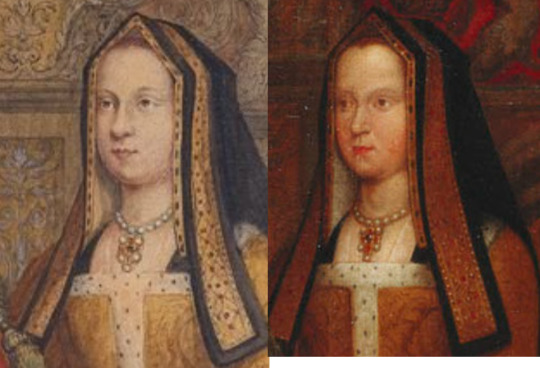
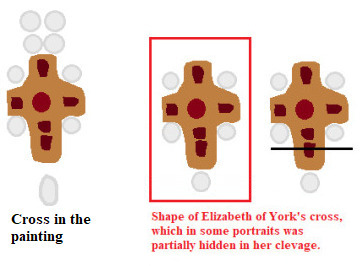
What is different? Bottom pearl and 4 extra pearls on it.
Imo it could be Elizabeth of York’s cross. I cannot rule it out.
Would Mary wear such old jewelry? 50+ years old?
Well I told you in past that Mary during her reign wore this:
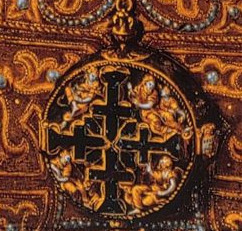
it’s called Tablet of Bourbon and experts have traced it in royal inventories all the way back to reign of Henry V. I didn’t mispell that. Henry the Fifth. He died in 1422! When Mary got depicted with it as Queen, that jewel was 130+ years old. So merely 50+ years old jewelry, she could definitely wear that!
(Wearing old jewelry by royalty is showcase of stability and continuity of line. Even nowadays royals do this and royal watchers discuss which royal lady wore this tiara/necklace/brooch before.)
Now let’s take a look at the second painting.
Trinity College, Oxford’s painting labelled as Elizabeth Pope, neé Blount. (They have 3 copies of it and it is really hard to tell them apart!)
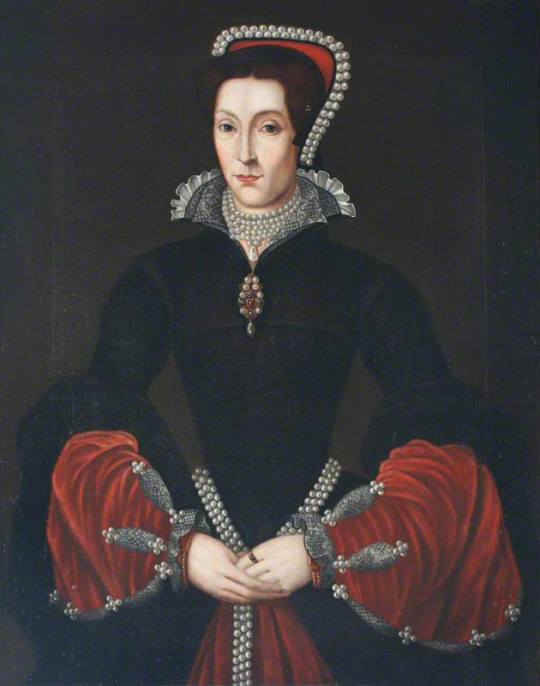
Link to right one(i hope):
https://artuk.org/discover/artworks/elizabeth-blount-lady-thomas-pope-c-15151593-formerly-basford-later-paulet-219507
Elizabeth Pope was wife of founder of the college. Lady of great ambition, and love for jewelry. Her husband was very rich, and at times very powerful.
And in no way his portrait matches his supposed wife:

Both have dark background and are dark to degree, but he has drappery( fabric hangings) behind himself(though it is not very visible), she has solid background. He wears lynx fur, his wife no fur. He wears no jewels(except rings), she wears SO much of it!
This amount of jewelry on non-royal?! Don’t get me wrong-in Elizabethean times-certainly possible and such pearl chains often occured in those days in portraits. But prior?! Not normal at all in 1550s nor 1540s.Should hit you as weird! Immediately. The crimson velvet should hit you as weird.
Yeah I know that guy funded college and was very rich. But in those days unless you were royal, you needed to show some restriction with how you were portrayed. Henry Howard’s got executed mainly because of his portrait! This is meant to be painted after...yet no restriction from those people?
Overall if I look at it together:
This jewelry+crimson+difference with alleged portrait of husband, don’t favour Elizabeth Blount that much.
But what do we know about her husband? Thomas Pope was one of Mary’s council members and favoured by her. (That could potentially explain why his wife could be allowed to wear something she’d normally be not entitled to. We had such case during Henry VIII’s reign.)
He founded the Trinity college as catholic college. During Mary’s reign. His action certainly would please her. Even if she wasn’t official patron, she was in favour of this. And old universities in UK have many lesser known portraits of Tudor royalty, hidden among many other old paintings. They get overlooked.
And if Henry VII could have been mislabelled as Richard III already in 16th century, Mary could have been mislabelled as Elizabeth Pope in 16th century also. Especially given it is atypical depiction of her(possibly). Hence it could certainly be Mary given painting’s history.
But if you look at both paintings, one thing is off. The height of brows is very high for Mary. Every other feature i can find in some portrait of her, can explain by different artists taking on her features, by her health issues, weight loss/gain.

Here look how same the shape of eyes is:

But not the brows. They are too high. It oculd be certainly that artist made mistake and her grandfather’s depictions sometimes have brows very down sometimes very up. So this is explainable.
(And certainly it looks more like her than that portrait in Met Museum. At least to me.)
(She could ahve same shape of eyebrows, which in slightly different angle and tilt of head just look very different.) And especially in copies this can happen. I cannot rule it out. It could simply be that it is poor likeness.
Or it is isn’t her. But Elizabeth of York’s cross and amount of jewelry points to royalty. Alive in 2nd half of 1540s or sometime in 1550s. It’s not Anne of Cleves. But who then?
I’ll be honest here. I do not know it is. I don’t. At least not for sure.
And I am sure many of you will say Mary...that it has her mouth etc...but knowing what I know about Scrots and Eworth...I cannot rule out some of these are artistic similiarities. The artist’s style in which all people, regardless of their actual features, looked alike.
That being said, there is aditional thing which we need to consider here.
The damage to the Illianois painting. It’s not obvious at first glance, unless you look in HD. But there is unfortunately damage to the face, which might mislead you great deal. There are dark patches where shadow shouldn’t be, smudges etc. And it is obvious to me, that those are not how the sitter is supposed to look. The painting’s face was just not restored to get rid of these.
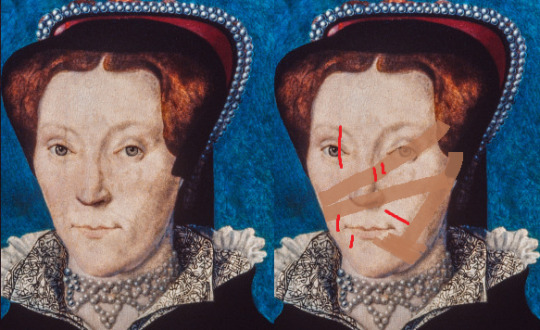
And imo due to this the woman looks maybe even decades older than she actually is. All those supposed wrinkles are actually damage to the painting if you focus on it. Thus...if you remove them, she looks much younger and with nose which at least from en-face or nearly en face, looked much straighter(than the damage makes it appear so).
Probably like this(it’s photoshoped-i wasn’t able to fix the nose entirely):
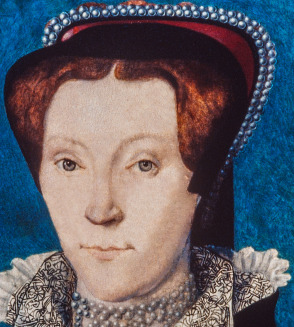
But how young is this woman? Is it 18? Is it 35? It’s hard to say.Mary looked still very young up to cca time of her father’s death(such were genes on her mother’s side of family), and who knows maybe Parr also looked very young.
I think dating for this fashion is c.1546+(after that it is hard to determine due to Mary I’s returning to fashion).
So could it be Mary or Parr in c.1547, or Elizabeth during her brother’s or sister’s reign? Yes, to all three.
But we also know Parr resembled Mary to great degree with main difference being more arched/higher brows.
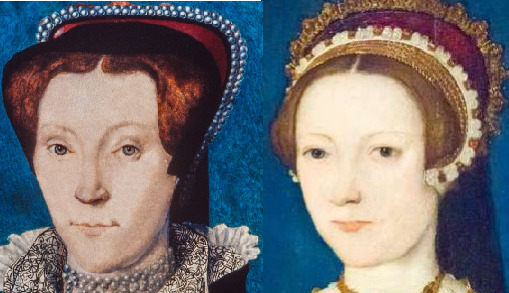
But i am not confident to say it is her. Because as you know, only original we have is not great and we are not 100% sure about her basic features.
Resemblence between Elizabeth and Mary was also pretty good. More than you’ve been told! She is good candidate too. She had hazel eyes-not brown as you imagine her, featurew-wise she would be pretty good fit.
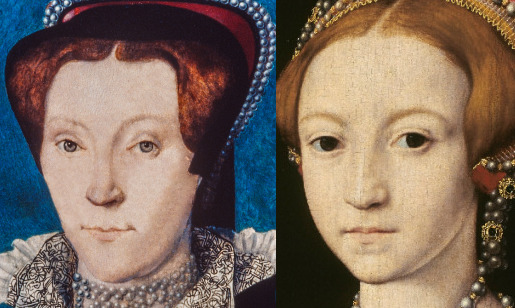
And we lack depictions of her from 1540s and 1550s-where she is on her own. she is in family portraits. Of course Mary has way more because she was ruling Queen and Elizabeth also was not in favour plenty of times in those years. Still there are just cca 3 painting of monarch’s daughter/sister in period of 20 years...(and 2 are based upon family portraits too). The amount is odd! There are bound to be more depictions of her we are not aware of!
Neither is excellent fit. Neither is bad enough fit for me to rule them out.
But while figuring sitter could be younger is good to know, me photoshoping the image and only then comparing faces was bad idea. Because I removed something which is damage and I only realised later.
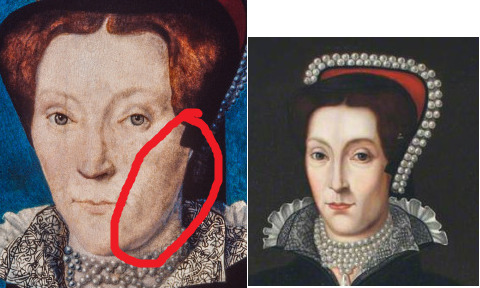
It’s the way cheeks are shaped. With prominent edge to it?(would I call this wrinkle? probably not). It’s kind of similiar to cheeks of Henry VII, but his were of course way more prominent due to age.
And it got me thinking. Could this detail help us narrow it down who it is?
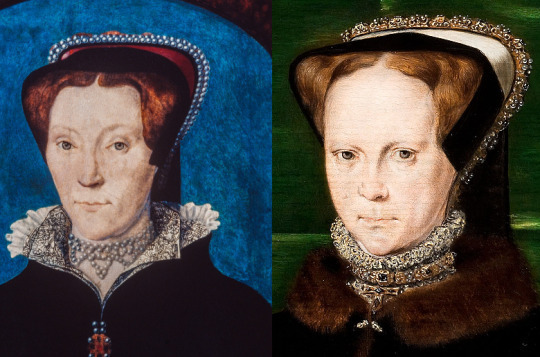
Mary’s cheeks are similiar, but in comparison she has this bulge sticking out of her cheeks. But perhaps that is due to some health condition. I don’t know about her reign but prior Mary had problems with her teeth few times. Could cause swelling in that area.
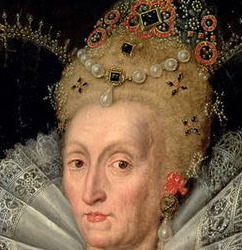
Elizabeth’s depictions if she had it as young woman, her youthful portraits don’t show it(they are idealized). But some of her portraits as old woman show her cheeks resembled that of her grandfather.
However I cannot rule out possibility Parr had it too.
I will be frank. I don’t know which one of them it is!
I’ve been trying to figure out for months now! And I keep changing my mind over whom i think it is. I have finished most of this post in winter. But I kept going all over their portraits, known depictions, features and I keep changing my mind about who i think it is, and then i changed it back and yet again! I’ve done it 6 or 7 times. I have to surrender and admit defeat.
I simply don’t know. At the moment you can take your pick-Mary I, Elizabeth I, Catherine Parr.
Go for it! Who do you think this could be?

I hope you’ve enjoyed this, because for me this was frustrating as hell.
PS: I know some of you speculate if it could be one of Henry VIII’s nieces. But I would like to caution you. if we are talking relatives vs relatives, it can be very hard to determine. You might be sure you found perfect match in features in some depiction of person you like...and still it might not be that person but their cousin who just happened to look very alike. Remember my post about Henry VII vs Richard III. Distant cousins-very similiar face.
Especially given the condition of the American painting, be cautious. I am not sure if nose can be restored properly-i hope so. But we might be looking at issue of flattening nose. And when that occurs it is very hard to tell who it is, because it is such defining feature. So it would be very easy to accidentally identify these portraits wrongly and sometimes it is better to leave it not identified, than wrongly identified.
#Tudor History#historical portraits#mistaken identity#Tudor Jewellery#Mary I Of England#Queen Mary I#elizabeth I#Catherine Parr#queen elizabeth i#elizabeth tudor#mary tudor#katherine parr#based upon jewellery it should be royal#i can't figure it out
8 notes
·
View notes
Photo
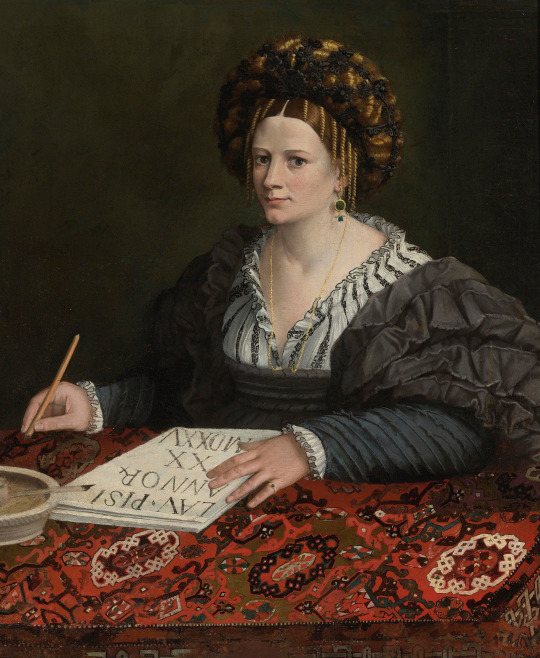


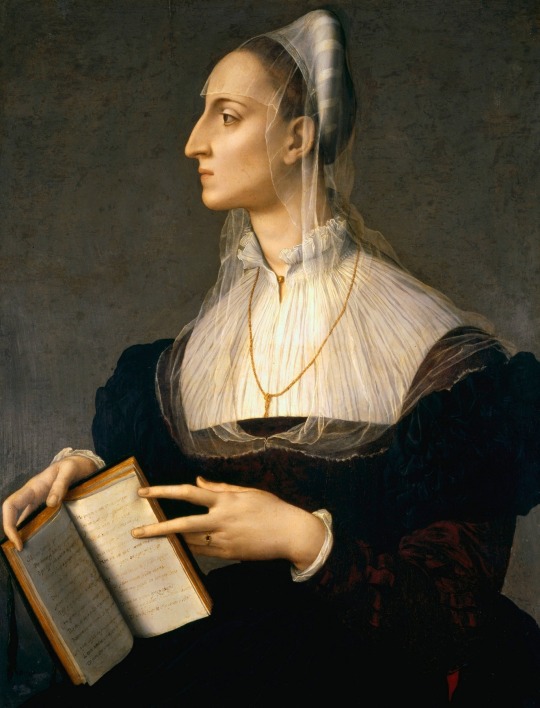



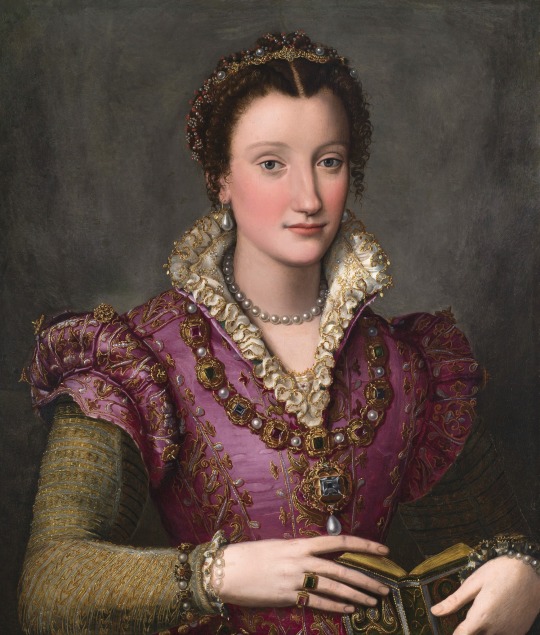

Touring the 1500s -
Top left 1525 Laura Pisani by Gabriele Cappellini (location ?). From tumblr.com/eirene; partially fixed.
Top right Diane de France, princess of France and daughter king Henry II of Valois by François Clouet (location ?). From tumblr.com/roehenstart/695196156597256192/portrait-of-diane-de-france-princess-of-france; fixed spots, but not cracks w Pshop 2048X2894.
Second row left Woman by ? Musée des Beaux-Arts de Dijon - Dijon, Côte-d'Or, Bourgogne-Franche-Comté, France). From tumblr.com/blog/view/history-of-fashion 597X800 @72 208kj.
Second row right 1550s Laura Battiferri by Agnolo Bronzino (location ?). From tumblr.com/blog/view/papered-in-rose-toile 1370X1795 @72 677kj.
Third row Woman by Florentine painter, possibly Jacopo Zucchi (Metropolitan Museum of Art). From tumblr.com/historical-fashion-devotee/700705910778216448/artthatgivesmefeelings-florentine-painter; fixed spots & cracks w Pshop 2015X2615 @72 1.5Mj.
Fourth row left 1545-1550 Lady, probably Philippine Welser, probably by Corneille de Lyon (Veste Coburg - Coburg, Bayern, Germany). From tumblr.com/blog/view/lenkaastrelenkaa fixed spots $ some cracks w Pshop 828X1200 @72 482kj.
Fourth row right ca. 1565 French Princess by the school of François Clouet (Morgan Library & Museum - New York City, New York, USA). From tumblr.com/dashboard 1078X1445 @72 665kj.
Fifth row lef. 1570 Probably Camilla Martelli by Alessandro Allori (St. Louis Art Museum - St. Louis, Missouri, USA). From tumblr.com/pipouch/696978340783030272/alessandro-allori-portrait-dune-dame 1741X2048 @72 1.3Mj.
Fifth row right Jungen Frau by Nicholas Hilliard (Bassenge - 1Dec22 auction Lot 6038). From their Web site 1070X2498 @144 7.6Mp.
#1500s fashion#Renaissance fashion#laura pisani#Gabriele Cappellini#straight hair#jeweled turban#partlet#V neckline#square neckline#French sleeves#François Clouet#Diane de France#jeweled headdress#high neckline#neckline ruff#crescent neckline#rolled sleeves#puffed cloth ornaments#jeweled hat#clerical neckline#long close sleeves#Laura Battiferri#Agnolo Bronzino#veil#Jacopo Zucchi#jeweled girdle#Philippine Welser#Corneille de Lyon#Camilla Martelli#Alessandro Allori
15 notes
·
View notes
Photo

1550s (possibly) Lady in black holding a book by Alessandro Allori (Sotheby's - 20May21 auction Lot 24). Removed spots, cracks, & flaws with Photoshop 1576X2000 @300 915kj.
#1550s fashion#Renaissance fashion#Alessandro Allori#straight hair#jeweled headdress#partlet#square neckline#crescent neckline#carcanet necklace#V neckline#girdle#long tapered sleeves#long sleeves#tapered sleeves#full skirt
47 notes
·
View notes
Text
Portraits of ‘Mary of Burgundy’-Part 2: Why so many?
Firstly I’d like to adress why the paintings are commonly mislabelled as Mary of Burgundy. It’s due to this pendant, which is then seen in portrait of her daughter Margaret of Austria. Realising paintings were 20+ years after she died, they then went with Margaret instead.

But it’s 100% not all same sitter in all 12 portraits. And the picture in middle bellow is the reason. Juana of Castile is on sides-and the girl in middle has Juana’s nose and great deal of resemblence.

Yet the paintings were created after Juana was locked up and there’d be no reason for this many portraits of her to be made in Netherlands. Most likely it is Juana’s daughter.
And we know from previous research that 3 Habsburg females looked nearly identical-Margaret, Eleanor and Isabella. And Mary’s features were pretty similiar too(in most depictions, this is bit of exception.).That is the reason why the women look so alike, they are Habsburg females!
But there were only 5 Habsburg females in total in correct timeframe(1510-1520). How could there be 12 depiction of them?!
My estimation for dating of these portraits is 1510-1514. Why?
-The paintings with black background were popular popular up to very late 1500s/early 1510s. After that we only see green, blue or picturesque background(at least in portraits of Netherlandish royalty)
Majority of these are workshop Master of Legend Magdalene, but one is probably by Coninxloo, who might have been new arival to the workshop. He died in 1513(after making fully or partially several royal portraits from early 1510s. In 1515 Bernard van Orley became Margaret’s favourite.
So for us to see style of mainly Master of Legend of Magdalene and bit of Coninxloo, strongly points to ealry 1510s. But if you really focus on it-there appear to be 4 diffferent hands at play(at least). But it’s same workshop 100%, And if my theory is correct, all hands would be needed to finish such big endavour.
Dating of c.1510-1514 is actually very important clue as to why so many portraits were made.
(But just small reminder, at this time the workshop kind of had issues with proporitions. So even though you might think in all 9 paintings is an adult, it might not be!)
There are 3 pairs of paintings-which are virtually same in almost every aspect.
Try spot the difference in these two(i’ll tell you in just moment):

Here the colour of hennin is different and one hallo is missing(probably painted out):

Here chest brooch has different shape-round vs diamond-shaped(could be alteration), the halo on left is partly painted out:

The first two are almost exactly the same, except different hues of some colours, which can be entirely due to darkening of the pigments and paintings being kept in different conditions.
But on left is version from UK, and on right is version from USA:

If i said that on right the painting is prior to conservation and on left after, you’d believe it 100%. They are beyond similiar and clearly done at exact same time. The american version is slightly smaller actually(probably sides were cut off), but because it is in poorer condition, i could not scale it down without details hiding away in the damage.
There is several details one should focus about:
-sorry i switched sides by accident(and am too lazy to redo it all)
Overall details of headwear(patterns on ‘hennin’, styling of ‘donut’)+lack of halo:



Because I assure you, in those 9 paintings, not all those details are same.
Long story short:
There are at least 4 different patterns of fabric, possibly 5.

(I am not sure if violet one is supposed to look as green one, or if it is its own pattern).
Further more provenly 2 styles of chains:s

2 styles of jars(dark green and light one):

3-4 style of chest jewels(diamond, round, clover, + possibly cross shaped)

and 2 styles of the henin:

2 different linings of under-parlet(dash line vs golden trim)

+one partlet is covering way more than in all other versions
Hands are painted in 2 different ways(on left more straight, on right more bend):

3 different pendants, once pendant hidden in clevage(hence only its ribon is visible+ that much bigger partlet) or no pendant.(5 different styles)

Plus 4 paintings have 1-2 more jewels in chest area.
But why?! Why would you make so many paintings, yet differentiate them?
And why sometimes(or possibly always) two versions of same painting?
Mass production doesn’t cut it. Just by glance, you can tell those are Habsburg features and royals liked to be depicted as various saints. But why multiple versions?
I have tried hard for weeks to come up with logical explanation and I can think of only one reason, one theory which would explain it all. A logical reason which fits the dating-early 1510s.
-Portraits for potential groom to pick bride from.
Yes, sometimes literally the grooms picked from the portraits the one he liked better. For example King Vladislaus II of Bohemia and Hungary(and Croatia) was offered two french brides-cousins. Anne of Foix-Candale and Germaine of Foix, but he picked Anne which according to him was prettier and Germaine later married Ferdinad II of Aragon.
But he only met Anne in person after she was married to him by proxy, and after she was crowned Queen of Hungary. So he must have picked her from portrait.
Habsburg females had almost identical looks, so they must have went to greater lenght to ensure portraits are not mixed up.
(Because even person who knew them could get it wrong.)
It’s likely that it was required(or expected) to dress the sitters same. But with 4-5 potential bride, they had to add very subtle differences to act as clues for probably ambassadors, so they could check if it is indeed girl they think it is.
If the portraits are ment for 2-3 different foreign courts, for two or three grooms to pick from, it’d explain why 2-3 versions of same portrait would always be created.
Would there be enough royal courts with unmarried royal males in between 1510-1514?
-Yes. Actually 6 courts had unmarried men-these included:
Christian II, King of Denmark, Norway and Sweden, born in 1481, m. 1514 to Isabella of Austria
Sigismund I, King of Poland and Grand Duke of Lithuania, born in 1467, m. in 1512 to Barbara Zápolya
Louis XII, King of France, born in 1462, was widowed in 1514, m. as 3rd wife Mary Rose Tudor in 1514
Vladislaus II, King of Bohemia, Croatia and Hungary, born in 1471 widowed since 1506
his son and heir, future Louis II, born in 1506-m. Mary of Austria
heir of Portugal, future John III of Portugal-m. Catherine of Austria
heir of Navarre, future Henry II of Navarre(unlikely)
Another royal male would be future Francis I of France-de facto heir of Louis XII. France forbidden women from inheriting, so neither of two daughters of Louis XII by Anne of Brittany could inherit, and Francis was the presumed heir to the throne. But French didn’t want to loose Britanny so Francis and Claude(the eldest daughter of Anne of Britanny) were engaged and it was clear they would marry. Hence I didn’t include him.
Ferdinand II of Aragon taken Navarre in 1512 and proclaimed himself its King, so it is highly unlikely negotations would have take place with Navarre.
By the way Mary of Austria was engaged to Louis II since before he was born(in 1506). So you might think, well her portraits should not be made, she was taken already.That’s not how royal bethrohals worked. Surprisingly often they got cancelled or brides/grooms switched etc.
But since she was picked, why would they sent her sisters to Bohemian-Hungarian court? Possibly to strenghten the alliance, by double match(or tripple-King Vladislaus had daughter) with intention to marry one of girls to widowed King. I will get into details as to why that alliance was so important, when I will do Geography of HRE and Bohemia.
Given that total amount of paintings is 12 and not 9, i think it is more likely we are looking at portraits intended for 3 courts, but that depends on number of sitters. 12 paintings with 4 sitters would fit nicely to 3 courts.
But had it been 5 sitters, then even if we assume first one is inspiration, we have one too many. Could be that one is a copy and not an original(but would fool me), or that several paintings were destroyed (fire or bombing in WW2 or theft are usual reasons for that).
Yet due to quality of photos of some of those 9, I am not sure if we are looking at 4 or 5 sitters. And had it been 5, it doesn’t help idenfication.
(We know from previous research that Margaret of Austria was depicted in one tapestry with 4 girls-all dressed same, yet she only raised 3 of her nieces. And we have no idea who could be the 4th. Unless of course there never was 4th girl truly with her, they just included Catalina at least in the spirit-depicted her with rest of them.)
We can group the paintings together based upon the patterns of the fabric on gown(I assume always the same one was assigned to each girl/woman):
Sitter A:

judging by features Margaret, Eleanor or Isabella
Pattern is five-petal flower with pointed petals

Sitter B:

This one might suggest portraits were sent to 3 courts and not just 2, because we have same sitter 3 times. But if this is indeed predates the rest of paintings:

Then possibly we’re looking at just 2.
I don’t think it could be Margaret, but realistically it could be any of the girls (despite the youthful face-that is actually normal for that family).
Personally i am wondering if it could Catherine. Mainly because to paint her, a workshop member would have to travel to Spain and then that workshop member would not be included in making of the rest. Perhaps he took with himself the painting in middle with him as guide for the outfit, but had free hand in the face.Then returning 2nd paintig of her was created, with different outfit, and face more style of master of legend of magdalene.
But I can be wrong.Idk, tbh.
Pattern is some flower with 6 round petals

Sitter C:

I know from my previous post that Juana’s nose was inherited only by Mary.
However Catherine’s nose from front was same too. But from side she had unfortuntely the same raise as Emperor Maxmillian. And since these would be painted probably in early 1510s, she’d be still a child and the nose’s raise might have not shown fully yet. So I cannot be 100% sure it isn’t her. Hence it is probably Mary or Catherine.
Pattern is sun? or flower with 6-8 very narrow petals:

Sitter D:

Honestly, I have no idea. Could be any of them.

Pattern is clearly flower with five oddly shaped petals, could be cornflower
Sitter F:


Pattern we cannot tell conclusively. Looks like oddly shaped bird to me. Or some tentacle monster.

And sometimes it seems to me like there are 5 pentacles rather than 4.
Since all previous ones appear to be showing flower it’s logical for this one to be as well. Flowers with just 4 petals exists actually, but all previous ones had 5+ petals. Hence idk what to think. Maybe the flower has some very specific shape, plenty do!
Idk what pattern do you think this is?

This time I might know which woman it might be. But I am not certain of it.
However in Ashwellthorpe triptych(on right bellow) Margaret was also painted kind of ugly. Don’t get me wrong, she had some unflattering depictions, but this one was kind of extreme. It makes me believe the painting was also intended to be viewed by foreign groom, and she bribed painter to make her look uglier.

Thus the picture on left being the most ugly from the group could also potentially be her.I guessing here big time though.
But i am not certain of it, not even like 50%. Hence sadly this time I have to accept the defeat, I can’t identify them this time.
So my conslusion after all this research is that conclusive identification is impossible. I can only identify the sitters as probably females of House Habsburg, unmarried in ealry 1510s. Which is all 5 of them!
Unless we find contemporary source which would specifically mention the differences in paintings and who is who.
Like letter to ambassador, explaining to him which female wears which pattern of fabric. Or if the girls picked thir own flower, perhaps we could find it depicted upon some personal item.
Otherwise we cannot be sure who the sitters are.
I hope you have enjoyed it.
8 notes
·
View notes